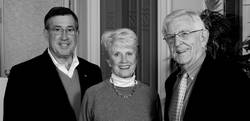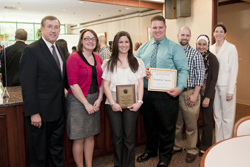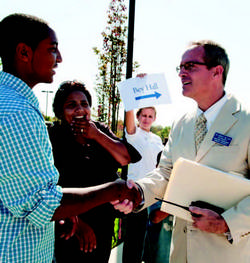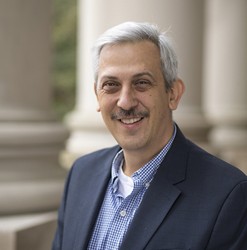For the first time in 10 years, the University’s Board of Trustees will have to find a new president following President Paul G. Gaffney II’s official announcement that he will retire on June 30, 2013.
Robert Sculthorpe, Chairman of the University’s Board of Trustees, commented that the next president needs to be a strong leader who understands the University’s goals and the direction in which the Board wants to take it. “I suspect there will be quite a few applicants who will be looking at this opportunity,” he said. “It’s basically going to take close to a year to find the next president.”
Grey Dimenna, the University’s Vice President and General Counsel, explained how the University selected Gaffney nearly a decade ago. Considering how well that process went, Dimenna said that the University will probably follow a similar course of action once Gaffney departs. As the current University president, Gaffney will have no say in who replaces him.
In 2003, the University used a search committee that was staffed by Dimenna. He was responsible for providing the committee with administrative support, such as scheduling meeting rooms, planning offsite interviews and handling traveling arrangements for candidates who were coming to the University to be interviewed. Dimenna did not have any say in the search committee’s decision.
“My guess would be, because the process worked so well, that the next process would probably be similar, but that would be up to the Board of Trustees and the search committee,” Dimenna said. “The one thing that I think would be certain is that next time they would probably form another search committee because that’s how people do things in higher education.”
The committee represented five groups in 2003. There were eight to nine trustees, as well as three faculty and two administrative members. The student body was represented by one undergraduate and one graduate student. Members of the committee were ultimately chosen by Paul S. Doherty Jr., the former Chair of the Board of Trustees. Currently, Sculthorpe would select the members of the committee.
Dimenna said that narrowing down candidates for the presidency consists of a general discussion among members of the Board who typically meet in Wilson Auditorium. As long as the majority of the Board approves of the same candidate, then he or she may be offered the position; unanimous consent is not required.
“Obviously, it would be better that the Board was in agreement on who the next president should be,” Dimenna said. “The Board of Trustees is the president’s boss. They have the right to ask the president to leave if they’re not happy with his performance.” Unanimity would be better, Dimenna added.
Sculthorpe said that the Board has not pondered any potential replacements yet. However, all will be considered, including internal candidates who already work for the University. “It will be a very open, transparent and thoroughly bedded process,” Sculthorpe explained. “We welcome anyone who would have an interest.”
In 2003, applicants for the presidency were required to meet with the search committee to facilitate the selection process. Gaffney recalled the meeting that took place at the Marriott Newark Airport Ho tel while he was still the President of the National Defense University in Washington, D.C. “It wasn’t on campus so we weren’t seen; it’s all pretty confidential at that point,” Gaffney said. “So my school didn’t know I was here [and] nobody here knew.”
Gaffney said that he was asked questions for about an hour and he quickly grew fond of the members of the committee. “They were really a great group of people who have proven to be great [during] the last nine years,” he said.
Following the hotel meeting, the candidates were narrowed down to four who were then brought to the University. “That was unbelievably hard,” Gaffney said. “You meet with the trustees, then they take your wife off and she meets with people without you there, and [we met] with the trustees at a social event, and I met with a faculty group, a student group; I met with athletes [and] alumni.” Gaffney then had to speak and answer questions in front of nearly 300 people in Wilson Auditorium. “It was nonstop all day and night, breakfast through dinner,” he said.
The process for the individual applicant lasts for roughly five months, while it takes nearly a year for the University to pick a new president, Gaffney said. Once a candidate is selected, he or she is called and offered the position by the Chair of the Board. “I got a call from the chairman of the search committee,” Gaffney said. “He called me at the National Defense University.”
A contract that determines the length of the new president’s first term is then negotiated between the candidate and Board. The number of years that a president will serve varies by contract since there is no preset number; however, the contract is typically longer than a year. For instance, Gaffney’s first contract was for three years followed by a renewal for three and a half years.
“My guess is that it would probably be in the neighborhood of three to five years,” Dimenna said. “The person coming in wants to know that [he or she] is going to have a certain amount of time here and a year isn’t really a long time to give people an opportunity.”
Since Gaffney has officially announced his retirement, the University can legally post a job opening for the presidency. The University’s advertising strategy will resemble that followed in 2003, Dimenna said.
Before Gaffney was identified, ads for the presidency were placed in various media sources, such as the Chronicle of Higher Education which is a weekly source of news and job information for college and university faculty members, administrators and students. The Chair of the University’s Board of Trustees sent letters to friends, donors and officials that announced the search for a new president and asked for suggestions. The University’s website carried the job posting and a search consultant was responsible for recruiting candidates who were deemed eligible for the job.
Finally, Dimenna said that the University used a document that he drafted called a leadership statement which consisted of three parts. The first part contained basic information about the University, such as the number of enrolled students. The second part spoke of eight or nine issues that the next University president would face. The third part spoke of characteristics that the search committee was looking for in the next president, such as leadership ability, fundraising skills and a sense of humor.
“[The Leadership Statement] will be composed of a number of pages that will list the attributes of the things that we’re looking for,” Sculthorpe said. “[It will] give a job description of what the president’s role is and obviously bring them up to familiarity with Monmouth University per se.” Sculthorpe added that the new Leadership Statement will be completed within the next several months.
“That was really our recruitment document,” Dimenna said. “If people were interested in the job, we would tell them to look at the document because basically it would tell them what we were looking for and what the successful candidate will have to do.”
Despite all of the advertisements, Gaffney said that he was informed about an opening for the University’s presidency while serving on a U.S. commission that dealt with ocean policy from 2000 to 2004. Gaffney was one of 16 commissioners along with his friend Lillian Borrone, who was the former Assistant Executive Director of the Port Authority of New York and New Jersey. Borrone informed Gaffney about the vacancy at the University and suggested that he apply.
“She knew some of the Board members and she said that the Board was great,” Gaffney said. He recalled her saying that it’s much easier to work in a private institution than a public institution because of the governance and that the campus is beautiful.
After visiting the campus during Thanksgiving weekend in 2002, Gaffney said that he decided to apply for the presidency. At the time he submitted his application, Gaffney also was a finalist for the presidency at the University of North Carolina, Wilmington; Georgia Tech’s Research Institute; and the Virginia Institute of Marine Science at the College of William and Mary.
PHOTO COURTESY of Jim Reme




